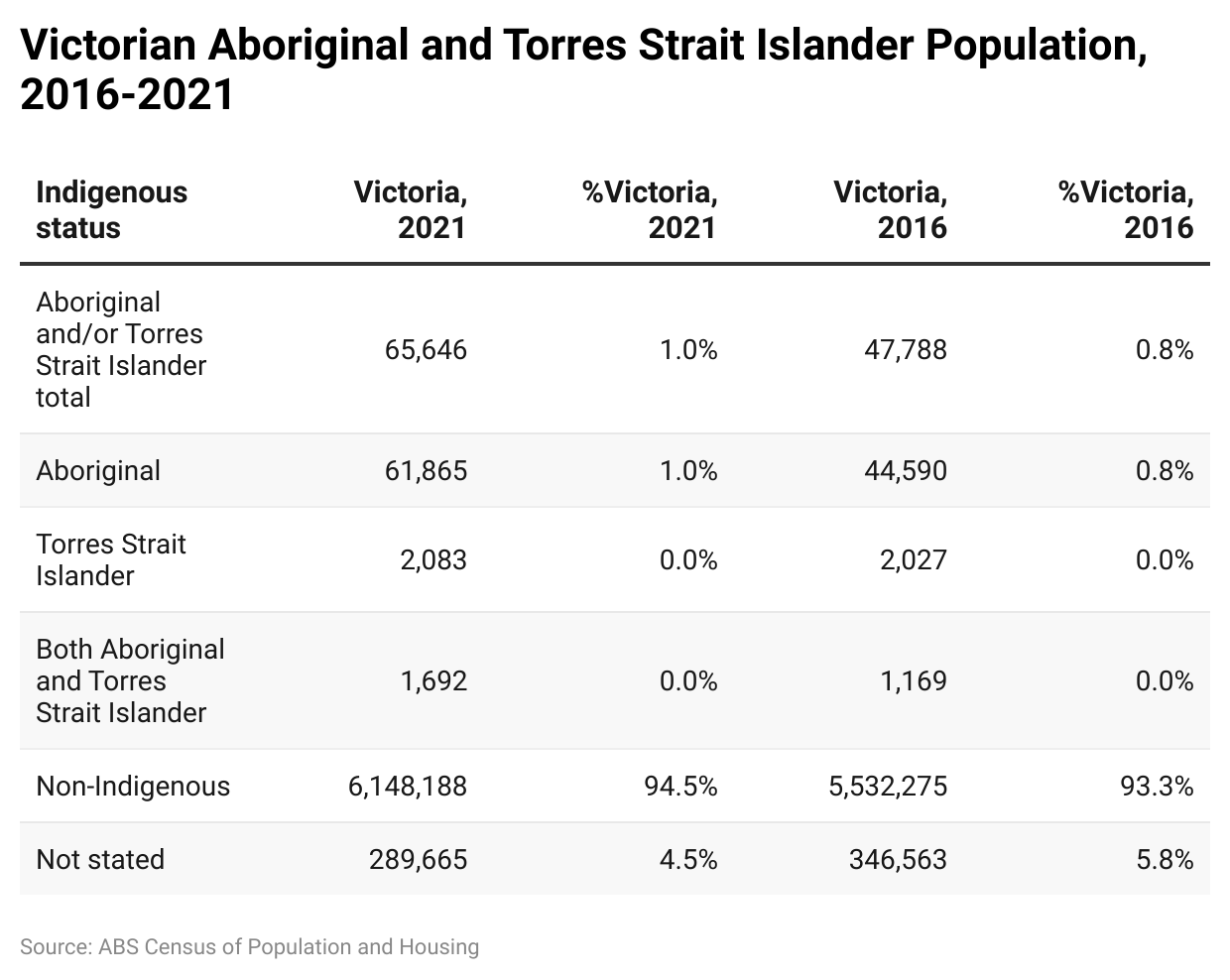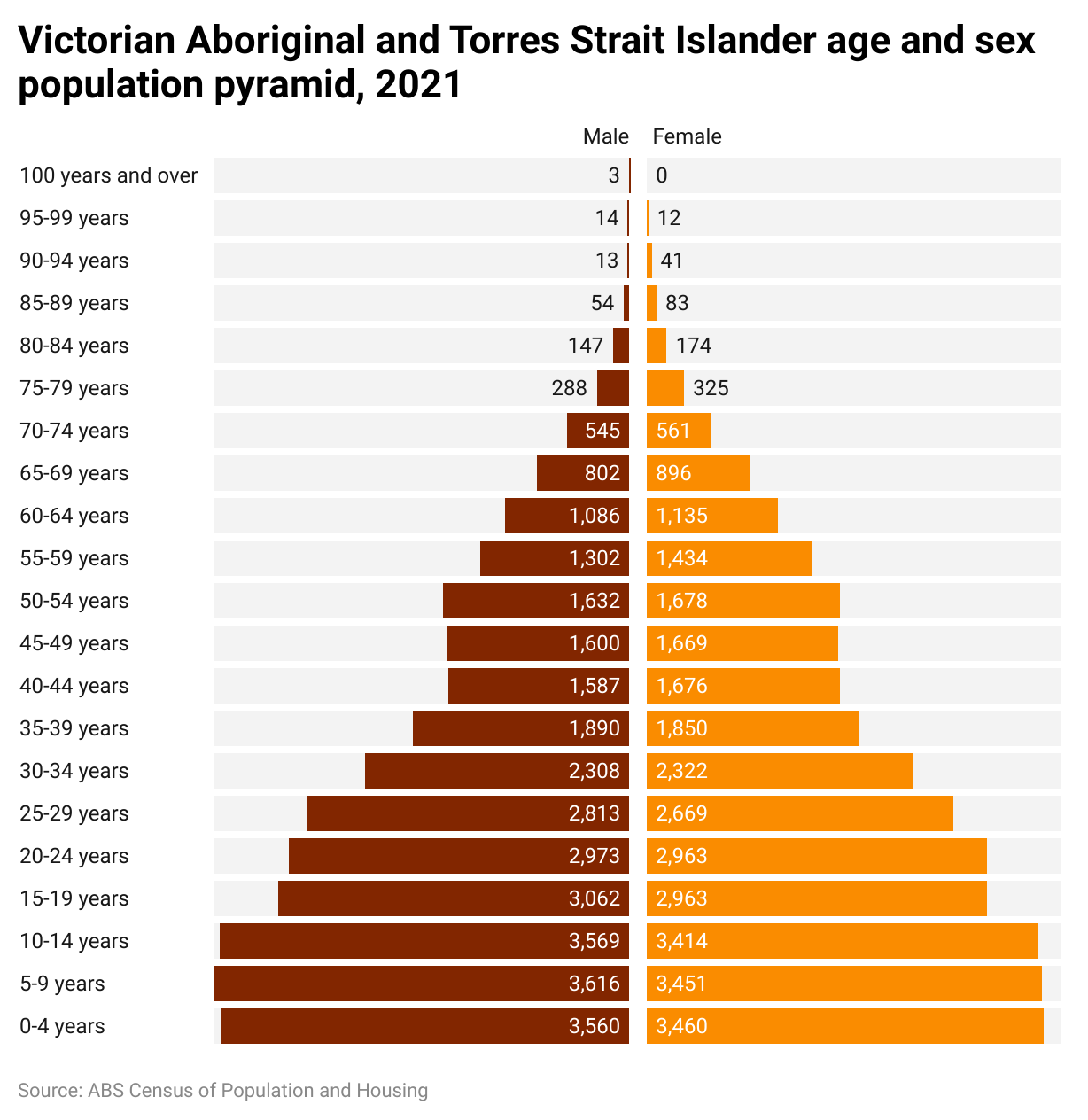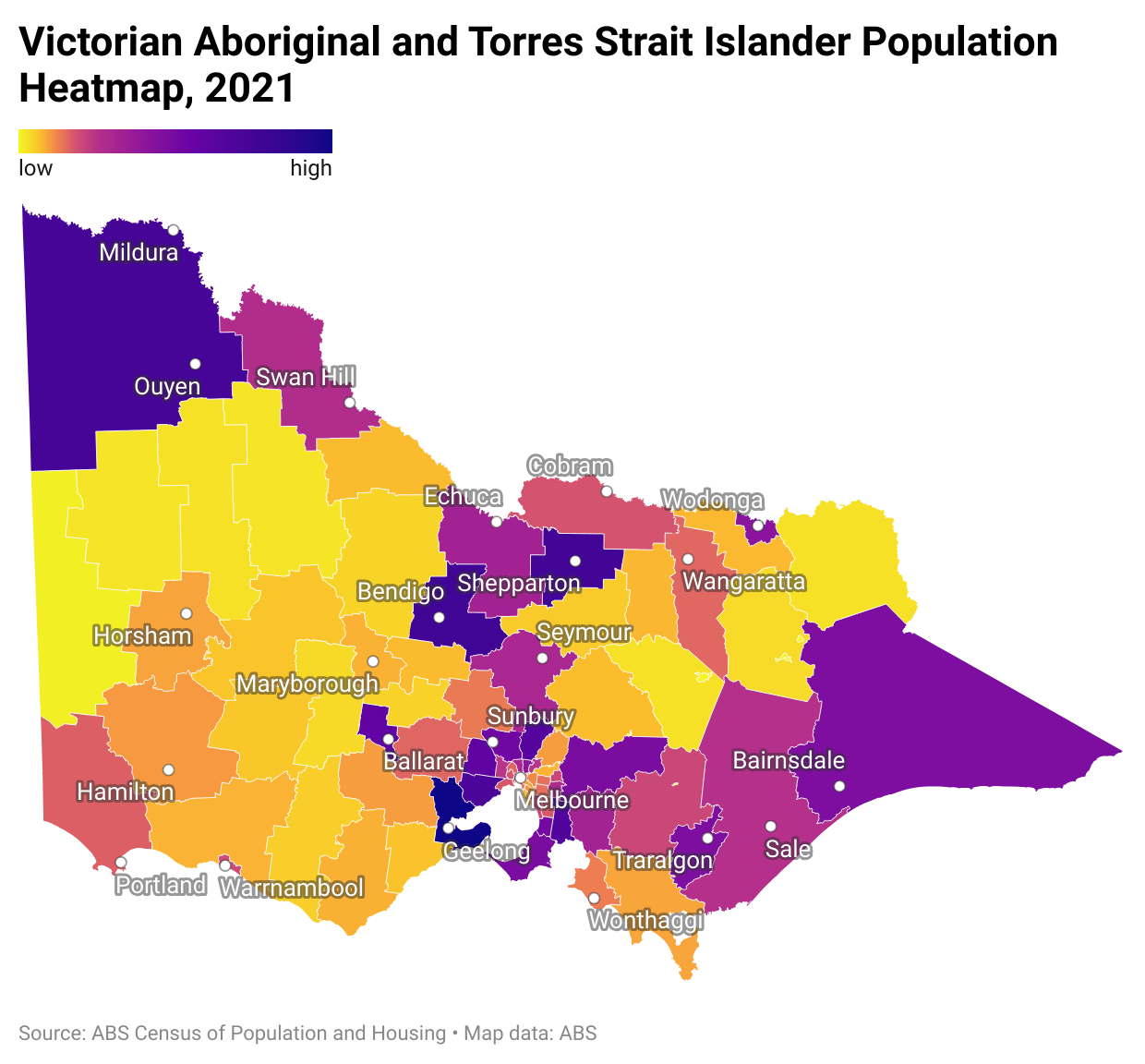Acknowledgment
We acknowledge the First Peoples of Victoria and their ongoing strength in practising the world’s oldest living culture. We acknowledge the Traditional Owners of the lands and waters on which we live and work and pay our respect to their Elders past and present.
We recognise that from time immemorial, First Peoples have practised their law and lore, customs and languages, and nurtured Country through their spiritual, cultural, material and economic connections to land, water and resources.
We acknowledge that the long-lasting, far-reaching and intergenerational consequences of the dispossession of First Peoples of their Country are a direct result of colonisation and the establishment of the State of Victoria. This history, and the systems it gave rise to, continue to harm First Peoples today. It is only through true Aboriginal self-determination that we can begin to right the wrongs of the past.
We acknowledge the strength and resilience of First Peoples in the face of historical and ongoing injustices, and the survival of their living cultures, knowledge and traditions.
Language Statement
Language is important and can change over time, and words can have different meanings for different people.
We recognise the diversity of First Peoples, communities and cultures throughout Victoria. While the terms ‘Koorie’ or ‘Koori’ are commonly used by contemporary First Peoples in southeast Australia to identify and differentiate themselves from First Peoples groups from other parts of Australia, this does not encompass the diversity of all First Peoples in Victoria. Unless overwise stated, we have used the term ‘Aboriginal’ or ‘First Peoples’ to include all people of Aboriginal and/or Torres Strait Islander descent who live in Victoria.
The glossary includes a list of acronyms and other terminology used in the Report.
Message from the Premier
This year, I had the profound privilege of being the first head of Government in Australia to participate in a truth-telling process, appearing before the Yoorrook Justice Commission.
It was an opportunity to acknowledge the injustices committed against First Peoples in Victoria since colonisation.
The murder. The massacres. The dispossession – of Country and of culture.
That the policies and practices of government have created the gap that exists between Aboriginal and non-Aboriginal Victorians.
That injustice is enduring – and despite efforts and intentions, there is still a long, long way to go.
Appearing before the Commission was also an opportunity to hear of the strength, resilience and resistance of Aboriginal people – of their unbroken connection to culture and Country for tens of thousands of years.
Our Government is committed to honouring that connection – and delivering on truth, Treaty and self-determination for First Peoples.
We must reckon with our past, be honest with our present and walk together for a fairer future for First Peoples and all Victorians.
This report is an important tool in recognising the progress we’ve made and the steps we must still take.
I want to thank the many Aboriginal Governance Forums and Ngarweeyan Maar-oo, the Koorie Caucus of the Closing the Gap Partnership Forum, for their contributions to this report.
Your work is changing our future.
Hon Jacinta Allan MP
Premier
Message from the Minister for Treaty and First Peoples
The Victorian Government Aboriginal Affairs Report 2023 is delivered in the context of the Victorian Government’s significant program of reforms toward First Peoples self-determination.
This Report provides key data to inform implementation of the Victorian Aboriginal Affairs Framework 2018-2025, Victoria’s overarching and ambitious framework to improve outcomes for and with First People.
As Victoria prepares for formal Treaty negotiations to begin in late 2024, this Report acknowledges self-determination is crucial in addressing ongoing systemic injustice and securing better outcomes.
Victoria is leading the way on early learning. In 2022, 100 per cent of eligible Aboriginal children enrolled in kindergarten. We know the experiences children have in early childhood directly impact their learning later in life.
In 2022-23 more Aboriginal people of all ages attended Aboriginal and Torres Strait Islander specific health checks and accessed aged care services.
Victoria's first Aboriginal sexual and reproductive health plan was developed, outlining priority actions to improve the sexual and reproductive with approaches based in self-determination.
This Report also shows us where we must direct future action. Aboriginal Victorians are still overrepresented in the criminal justice system and the child protection system.
The Victorian Government is working closely with Aboriginal communities to devise and implement the structural changes needed to deliver lasting change.
At a time of such significant change, the 2023 Victorian Government Aboriginal Affairs Report focuses our attention on the experiences of First Peoples in Victoria.
The Hon Natalie Hutchins MP
Minister for Treaty and First Peoples
About this Report
The purpose of the Victorian Government Aboriginal Affairs Report (Report) is for the Victorian Government to annually report on progress against the Victorian Aboriginal Affairs Framework 2018 - 2025 (VAAF), the Self-Determination Reform Framework (SDRF), the National Agreement on Closing the Gap (National Agreement) and the Victorian Closing the Gap Implementation Plan 2021-2025 (Implementation Plan). The Report is an outcomes measurement and accountability tool that provides valuable information about progress and challenges that still need to be addressed.
The VAAF and the Victorian Closing the Gap Implementation Plan have been extended until June 2025 to allow time for ongoing consultation with First Peoples stakeholders to self-determine next steps in the development of a new framework in the context of Treaty.
The VAAF is the guiding framework in Aboriginal affairs and the Report outlines progress towards achieving
the vision of the VAAF:
‘that all Aboriginal Victorian people, families and communities are safe, resilient, thriving and living culturally rich lives’.
The Report sets out how government is working to realise the VAAF’s 20 goals across six domains:
- Children, family & home
- Learning & skills
- Opportunity & prosperity
- Heath & wellbeing
- Justice & safety
- Culture & Country.
The Report also outlines ongoing work across government to progress First Peoples’ self-determination in line with the SDRF. Under the SDRF, Victorian Government departments and agencies are continuing to reform internal processes, practices and policies to better enable Aboriginal self-determination. This includes the Victorian Government’s journey towards Truth and Treaty, in partnership with the First Peoples’ Assembly of Victoria (First Peoples’ Assembly) and informed by the Yoorrook Justice Commission’s historic inquiry. The Yoorrook Justice Commission is the first truth-telling process into the historical and ongoing systemic injustices committed against First Peoples in Victoria since colonisation. Treaty in Victoria is the embodiment of First Peoples self-determination and provides a path to negotiate the transfer of power and resources for
First Peoples to control matters which impact their lives.
Victoria’s priorities under the VAAF and the SDRF are complemented by our commitments under the National Agreement. Victoria is pursuing more ambitious and comprehensive outcome-focused goals under the VAAF and Victoria’s Implementation Plan, over and above targets set under the National Agreement.
This is the fifth annual Report against the VAAF since its release in 2018 and for the third year, the Report embeds dedicated reporting on progress in Victoria to implement the National Agreement and Victoria’s Implementation Plan. The Report showcases the most up-to-date available data across the 111 measures in the VAAF and 19 socio-economic targets under the National Agreement. As detailed in the About Data section of the Report, the latest year of available data varies due to the inconsistent frequency of data collection across a range of data sources. The Report also features case studies about the impact of reform and investment on the lives of First Peoples. The case studies focus on examples of policy and programs shaped by the Aboriginal community-controlled sector.
The Report was developed through a coordinated and collaborative approach with input from Victorian Government departments and agencies. Many Aboriginal Governance Forums and Ngaweeyan Maar-oo, the Koorie Caucus of the Closing the Gap Partnership Forum, also provided input.
About Data
Cabinet and Machinery of Government changes
During the reporting period, the Hon Jacinta Allan MP was sworn in as the 49th Premier of Victoria in September 2023. There was a Cabinet reshuffle in October 2023 and this was supported by some Machinery of Government changes that became effective from early 2024.
Data collection and limitations
This Report provides the latest available information about how the Victorian Government is progressing against the six domains and 111 measures in the VAAF. The data reported provides an assessment of progress based on available data. Historical data may have been updated since the last edition of the Report.
Data has been sourced from a range of State and Commonwealth administrative collections and surveys. The latest year of available data varies across the Report due to the inconsistent frequency of collection of survey data. Several measures do not have updated data available for inclusion in this Report. Updated data for these measures will be included in future reports.
Some of the data reported against the VAAF measures does not directly align with the measure definition due to the limitations of available data.
Crude rates
Due to the large array of data sources used to calculate progress against each measure, most rate calculations used in this Report are crude rates. Where age standardised rates have been used, this has been noted in the Report.
Closing the Gap data
Under the National Agreement, socio-economic targets are set as ‘national targets’ and require a collaborative approach from all jurisdictions to achieve them. Assessments of progress for the Closing the Gap targets are included on the overview page for each relevant VAAF goal based on the latest available data. Further data for some targets is expected to be released in July and October 2024. Over time, as more data becomes available, the monitoring of the targets will provide greater insight into what progress is being made.
For some targets (such as Target 1 and Target 14), reporting is currently only for those jurisdictions which have adequate levels of Aboriginal and Torres Strait Islander identification. Future reporting aims to include additional disaggregation for all states and territories.
As Victoria is pursuing more ambitious and comprehensive goals under the VAAF than the targets set out under the National Agreement, many VAAF goals and measures do not have a counterpoint under the National Agreement for direct comparison.
Further information on national and jurisdictional progress towards the Closing the Gap targets, including data specifications, can be found at www.pc.gov.au/closing-the-gap-data/dashboard.
VAAF Data Dashboard
In line with the Victorian Government’s commitment in the VAAF to improve data access, transparency and narration, an interactive VAAF Data Dashboard has been developed.
The VAAF Data Dashboard can be accessed via the First Peoples – State Relations website at www.firstpeoplesrelations.vic.gov.au/report-data-dashboard. It offers a user-friendly platform to access detailed state level data. It also includes disaggregated data at sub-state level where available. While this Report is limited to the data available during the reporting cycle, the VAAF Data Dashboard will be updated to report on measures when new data become available.
Indigenous Data Sovereignty
The Victorian Government acknowledges the critical importance of Indigenous Data Sovereignty. Resourcing Aboriginal people and organisations to collect, analyse, disseminate and manage data supports self-determination.
Victorian Aboriginal Population
Between the 2016 and 2021 Census of Australian Population and Housing (Census), the number of people who self-identified as Aboriginal and Torres Strait Islander in Victoria grew from 47,788 to 65,646 (1.0 per cent of the total Victorian population).
Demographics
Based on the 2021 Census, 50 per cent of Aboriginal Victorians were under the age of 25.
Geography
Based on the 2021 Census, 50.5 per cent of Aboriginal Victorians lived in the greater Melbourne area. The Local Government Areas with the highest density Aboriginal population are located around regional centres, such as Greater Geelong, Greater Bendigo, Greater Shepparton and Mildura.
Updated





